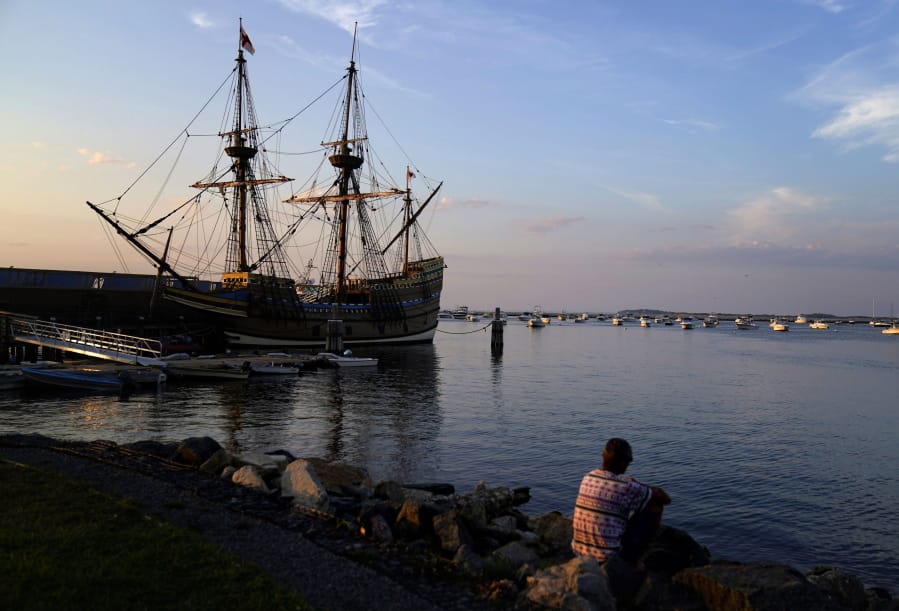The year 2020 was supposed to be a big one for the Pilgrims.
Dozens of events — from art exhibits and festivals to lectures and a maritime regatta featuring the Mayflower II, a full-scale replica refitted over the past three years at a cost of more than $11 million — were planned to mark the 400th anniversary of the religious separatists’ arrival at what we now know as Plymouth, Massachusetts.
But many of those activities have been postponed or canceled due to the coronavirus pandemic. And historian Elizabeth Fenn finds a certain perverse poetry in that.
“The irony obviously runs quite deep,” says Fenn, a history professor at the University of Colorado Boulder who has studied disease in Colonial America. “Novel infections did MOST of the dirty work of colonization.”
Disease introduced by traders and settlers — either by happenstance or intention — played a significant role in the “conquest” of Native people. And that inconvenient fact, well known to the Natives’ descendants, is contrary to the traditional narrative of the “New World.”
That narrative has been attacked in recent months, as statues of Pilgrim predecessors Christopher Columbus, Spanish conquistador Don Juan de Oñate and other “colonizers” have been toppled and defaced. The counter-narrative sees people like the Pilgrims not as rugged pioneers and adventurers, but as part of a slow-motion genocide.
“The Mayflower came and the settlers came, and they’re considered FOUNDERS,” says historian and journalist Paula Peters, a member of the Mashpee Wampanoag Tribe. “But in fact, they were takers.”
___
Plymouth wasn’t the first or the largest or most successful of the English settlements. But it has taken an outsized place in the American story.
“Regardless of anything that came before or after, Plymouth is the ‘once upon a time’ to the story of the United States — the symbolic, if not literal, birthplace of our Nation,” declares the website for Plimoth Plantation, a reconstructed Pilgrim settlement and living history exhibit.
But the 102 passengers aboard the Mayflower — equal numbers “saints” and “strangers” — did not cross the Atlantic to establish a democratic society. When they set sail from Plymouth, England, on Sept. 16, 1620, they were escaping religious persecution — and looking for a place where they could prosper.
After more than two months at sea, the Pilgrims landed at the place the Wampanoags called Patuxet, meaning “at the little falls.” When they disembarked from the leaky, fetid carrack, they stepped foot on a land already cleared by death’s scythe.
In the years preceding the Pilgrims’ arrival, the Native inhabitants of southern New England had been ravaged by what some scientists refer to as a “virgin soil” epidemic. The unidentified disease, perhaps introduced by European fishermen who plied the waters from Maine to Narragansett Bay, burned through village after village, killing up to 90% of some tribes.
“I passed along the coast where I found some ancient (Native) plantations not long since populous, now utterly void; in other places a remnant remains, but not free of sickness,” Capt. Thomas Dermer wrote in a 1619 letter to a friend back in London.
Dermer’s guide was Tsquantum — the Native interpreter better known as Squanto, who had been among 20 Wampanoags kidnapped by English explorers in 1614 and sold into slavery.
Dermer wrote that “my savage’s country” was once home to roughly 2,000 souls.
“All dead,” he said.
“Portions of coastal New England that had once been as densely populated as western Europe were suddenly empty of people, with only the whitened bones of the dead to indicate that a thriving community had once existed along these shores,” Nathaniel Philbrick wrote in his 2006 bestseller, “Mayflower.”
Most American children grow up with the feel-good story of the Pilgrims: How Pokanoket sachem Massasoit extended the hand of friendship to the English settlers, helping them survive their first winter on these shores, and later joining them for the first Thanksgiving feast.
But there is a darker side to that tale, as related by Mayflower passenger Edward Winslow in his 1624 tract, “Good Newes From New England.”
According to Winslow, Tsquantum spread a rumor that the Pilgrims kept barrels of plague buried in their storehouse, “which, at our pleasure, we could send forth to what place or people we would, and destroy them therewith.”
According to Winslow, the interpreter used the threat of plague to strengthen his own position among his people. If true, the Pilgrims were all too willing to play along.
When Hobbamock, one of Massasoit’s warriors, asked if they did indeed have such a weapon, one settler replied: “No, but the God of the English had it in store, and could send it at his pleasure to the destruction of his and our enemies.”
The recent epidemic had decimated the Pokanoket, but had largely spared their chief rivals, the Narragansett. Some historians have suggested that Massasoit helped the Pilgrims, not of out kindness, but necessity.
Whether formed out of pity, fear or pragmatism, the alliance between Massasoit’s people and Plymouth did not last long.
Within 55 years of the Pilgrims’ arrival, his son Metacomet — better known as King Philip — was rallying the region’s tribes to push the English back across the sea. And Gov. Josiah Winslow, Edward’s son, dispatched soldiers into the forests and swamps to hunt them down.



